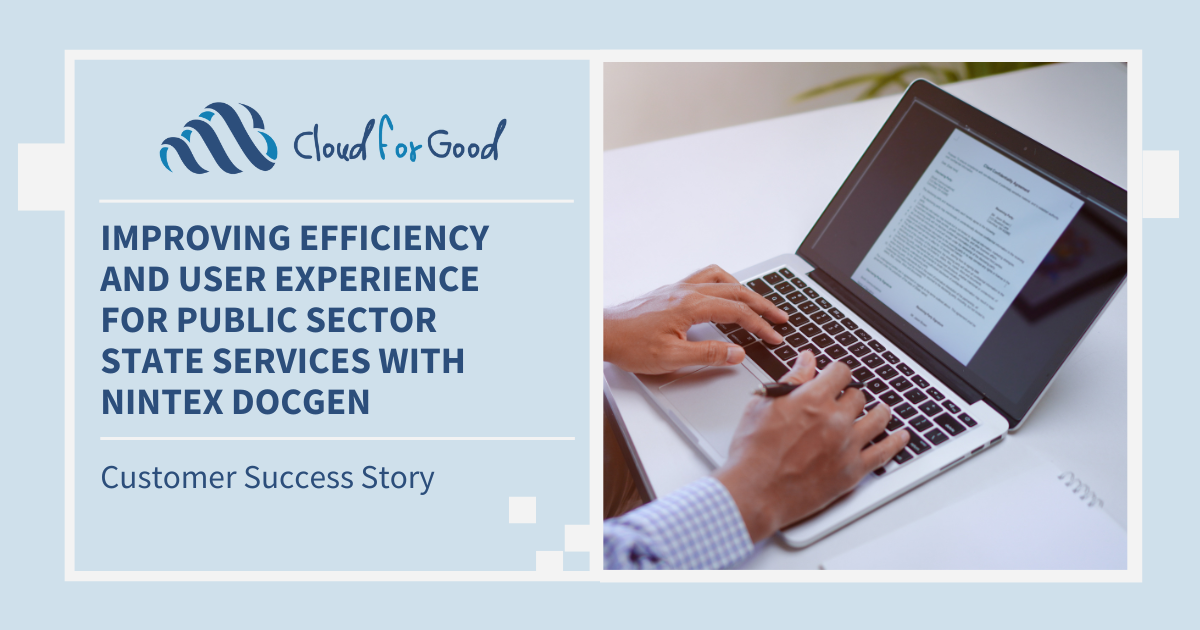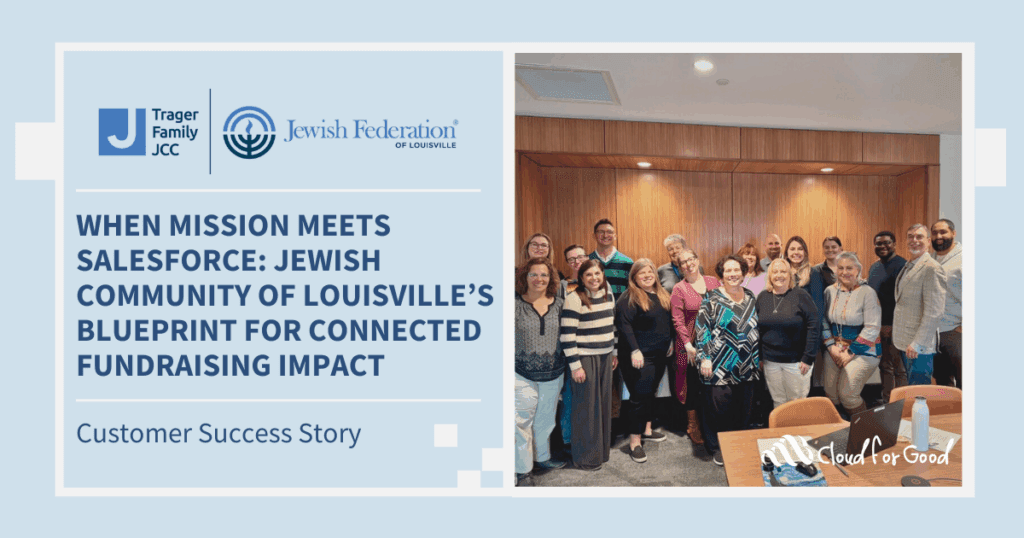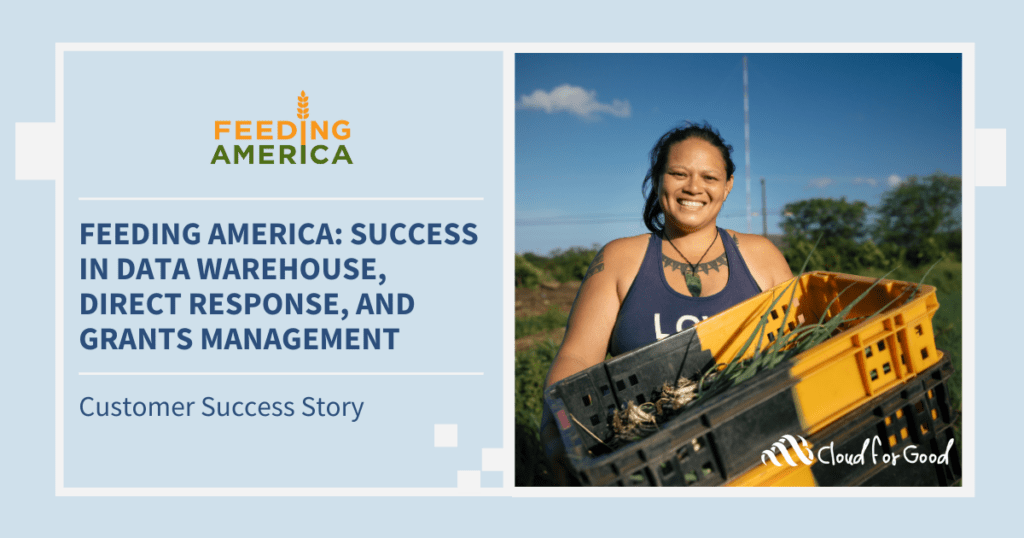Written by Gianna Weissensel
Cloud for Good partnered with a public sector client looking to transform its document generation solution. The client, an administrative department for a state government, supports the efficient operation of state agencies and groups and provides innovative solutions and programs for state government customers serving the interests of state residents. These programs include procuring goods and services, delivering information technology and mail, training and recruiting personnel, promoting equal access to the state workforce, leasing and managing facilities, payroll processing, and print publications.
The Challenge and Opportunity
The client runs a nationally recognized online portal powered by Salesforce Experience Cloud, and one of the portal’s primary capabilities is enabling business users to complete and file documents and forms online. This portal serves as a single, dedicated website that offers state businesses a cost-effective online filing and payment platform, helps simplify business relationships with government and state agencies, and provides access to a variety of state services. The client also partners with local governments to allow businesses to file and pay select municipal state income taxes online on the portal. There are 24 form service areas in the portal encompassing a wide variety of use cases and users, including an equal opportunity division, job and family services, and opportunities for residents with disabilities.
At the time, the portal leveraged Conga Composer as its document generation software to populate data into predefined transaction-specific templates. There were originally 166 transaction types in the portal, and each transaction type had associated report artifacts (such as transaction receipts, payment receipts, and summaries) that would be generated from among 170 artifact templates stored in Conga.
However, the client found that Conga was not living up to its document generation expectations. Constituents who were using the portal’s downloading features could not see any changes to their form process, which put a strain on the client’s constituent support system and inhibited their ability to have a seamless transition user experience. The client also reported ADA compliance issues with Conga, which made it difficult for users with disabilities or accessibility needs to read forms in the portal’s screen interface.
Consequently, the client selected Nintex DocGen for Salesforce as its new document generation solution. However, the client needed an implementation partner who could not only implement Nintex DocGen and migrate its Conga forms into Nintex DocGen, but who also had prior experience and significant expertise with Conga’s and Nintex’s products to know how to convert Conga form templates into functional Nintex form templates. Through a referral from Nintex, the client reached out to and selected Cloud for Good as its implementation partner.
The Solution
Migration into Nintex DocGen
Cloud for Good worked with the client to migrate the portal’s form templates from Conga into Nintex DocGen for Salesforce. Initially, 170 portal documents in Conga were planned to be migrated into Nintex DocGen. However, by leveraging Nintex logic and automation tools that helped consolidate some templates, the final number of Conga form templates migrated was trimmed down to 135 forms.
Conversion of Forms from Conga to Nintex
Following the form migration, Cloud for Good collaborated with Nintex to convert the Conga forms into Nintex forms, with a goal of launching and making Nintex DocGen functional for portal use by a November 2023 deadline.
Cloud for Good performed the Conga form conversion by building and deploying Nintex DocGen packages based off of templates from Conga’s Template file. Nintex helped Cloud for Good in completing the code related to these templates through 13 Apex classes along with 1 VF page to ensure that the converted documents could be generated and accessed by end-users through the portal.
The converted Nintex forms would then be used and adopted by the client’s approximately 600 internal portal users and their 854,000 external portal users—of whom 550,000 generate documents—without any noticeable changes for users on the front end.
The Results
Nintex DocGen Increases Document Generation Efficiency
As a result of transitioning to Nintex DocGen and converting existing form templates in Conga to Nintex templates, the client has an enhanced document generation solution that not only creates and enables online forms for portal, but also drives document generation efficiency by:
- Generating documents in batches using native Nintex tools
- Maintaining document generation efficiency
- Increasing form automation and template consolidation with conditional logic
Now that it has an easy-to-use, accessible platform where staff can make any changes to form templates as needed, the client plans to add more Nintex templates in the future.
Improving User Experiences for Client Staff Users and Portal End-Users
The migration and conversion of portal form templates from Conga to Nintex DocGen has enabled a more seamless user experience for the client’s staff and external portal end-users. Under the new system:
- Documents are generated by either one of two ways: most commonly through Experience Cloud (which the portal runs on), or through a Regenerate button that is used by backend client staff on Salesforce
- Forms have been tested for ADA compliance and are also enhanced for users with accessibility needs
- Portal end-users can download and print templates and documents based on business processes
- Client staff and portal end-users can regenerate documents anytime as needed
- Nintex DocGen processes updates directly in the client’s Salesforce org to ensure Nintex requirements and compatibility are met
In addition, calls on user troubleshooting questions to the client’s constituent support system have decreased.
As an integral part of digital government strategy in the state, the portal was created to provide businesses with an easier means of complying with multiple regulatory requirements, reduce or eliminate administrative and postage costs, repetitive data entry, and mathematical errors, improve service quality, remove barriers for developing online applications, and drive significant exposure to the portal’s growing userbase. Thanks to Cloud for Good’s and Nintex’s joint efforts, the improved portal—from its more efficient document generation functionalities, seamless self-service capabilities, to its enhanced user experiences—is now more closely aligned with the state’s digital strategy. Furthermore, through the improved portal and its elevated functionalities, the client and, in turn, the state government are equipped to provide even greater value and benefit to the constituents they serve.
To learn more about Cloud for Good’s service offerings for public sector and state and local organizations, and to access additional resources on Salesforce solutions for public sector, visit our Public Sector and State and Local industry pages.
You Might Also Enjoy:
Blog: Empowering State and Local Government with Salesforce Public Sector Solutions
Success Story: How Cloud for Good is Innovating the Indiana University Advancement Experience with Salesforce
Success Story: Reach Out and Read: Transforming Gift Reporting with Apsona and Managed Services





